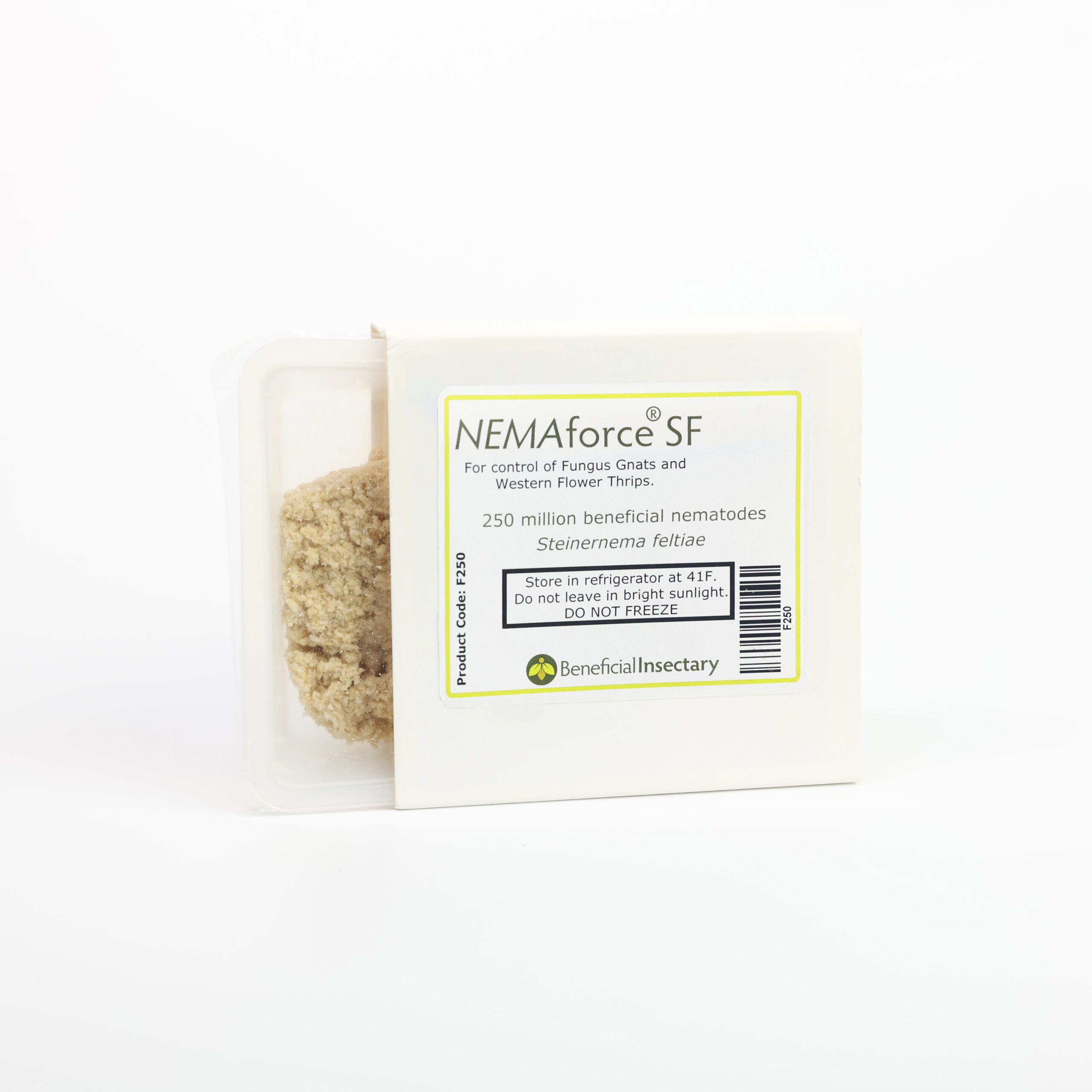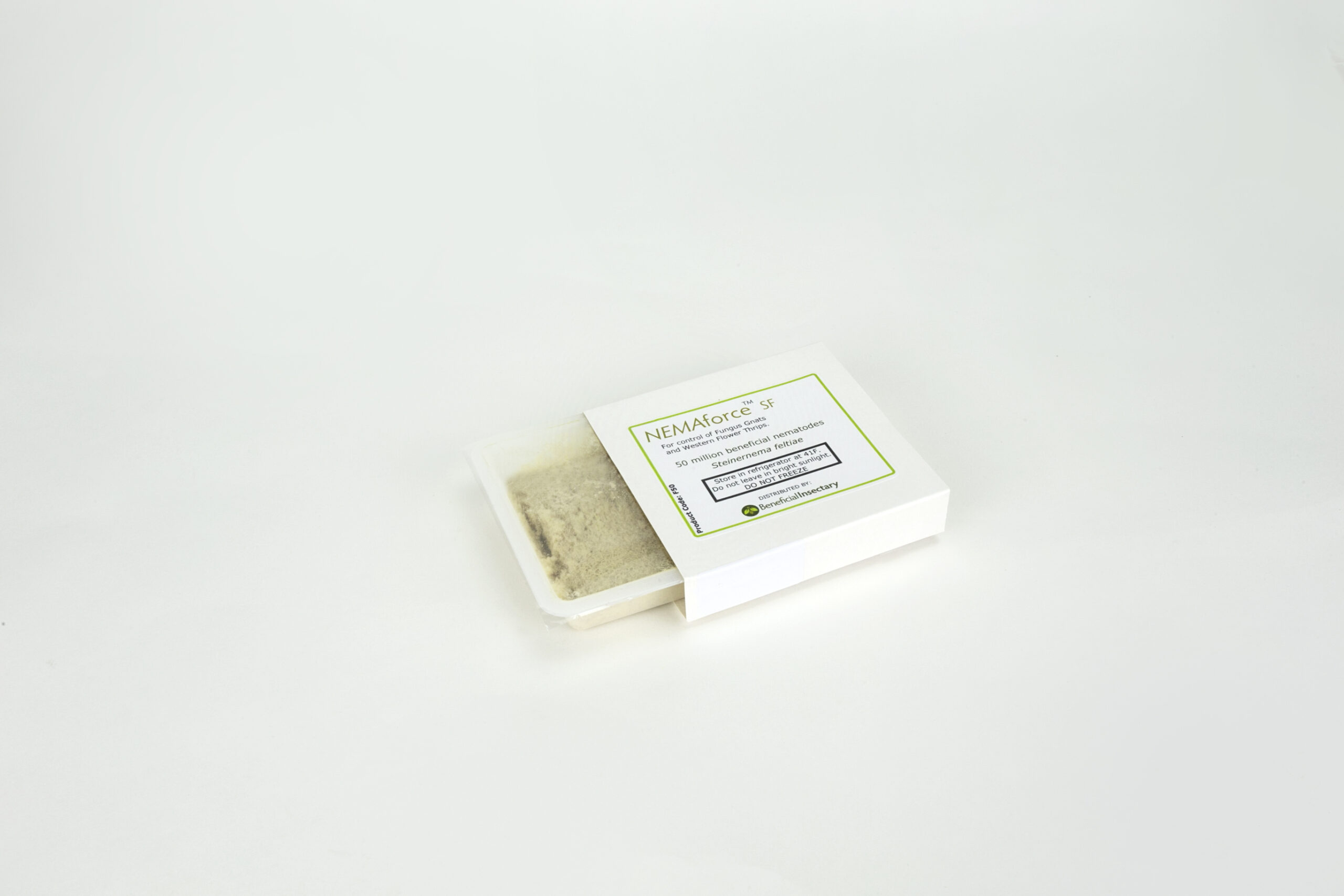NEMAforce™ SF
NEMAforce™ SF
Entomopathogenic nematode (EPN) Steinernema feltiae
Contains an insect-killing symbiotic bacteria, Xenorhabdus sp.
Optimal soil temperature range is 50-78°F
Intermediate forager, they prefer to live 1-2” below the media surface.
Mix of ‘cruising’ and ‘ambush’ style attack.
Fungus Gnat Larvae
Shore Fly Larvae
Mushroom Fly Larvae
Western Flower Thrips, Onion Thrips, other Thrips spp. Adults, Larvae, and Pupae.
Ornamentals
Hemp/Cannabis
Vegetables
Mushrooms
Soft Fruits
Tree Nurseries
Greenhouses
Indoor Facilities
Fields
Gardens


Infectious juvenile nematodes penetrate the host through natural orifices.
Once in the body cavity, the symbiotic bacteria are released, killing the host insect within 24-48 hours. The nematodes will grow and multiply in the dead host. New infectious juvenile nematodes leave the dead host in search of other pests.
Upon receiving the product, please remove it from the shipping packaging and use it immediately or store it in a refrigerator at 41ºF (5ºC). DO NOT FREEZE. Ensure good air circulation around each tray. Do not use it if you are past the expiration date or incorrectly stored.
Disposal
Product and packaging waste resulting from this product, or unused, outdated product, may be disposed of on-site or at any approved waste disposal facility under federal and local regulations.
NEMAforce™ SF can be applied by using standard spray application equipment, including tank sprayers, backpack sprayers, and irrigation injection systems. Remove any filters on spray equipment, if applicable.
Moisten media to about 75% capacity.
Fill spray vessel or stock tank with half of the required cool, clean water.
Start agitation and add the required number of nematode trays.
Continue agitation while mixing and filling the spray tank to the required volume.
Total spray volume for nematodes should be sufficient to get them 1-2” below the media surface.
Maintain agitation during application to ensure uniform dispersion of nematodes.
If applying to foliage, do so on an overcast day. Use as little water volume as possible to cover the leaf surfaces and use a wetting agent. Humidity must also be kept high, and lightly misting the plants with water half an hour after application can help.
Once they are applied, finding Steinernema feltiae in the soil will be challenging. The best way to tell if they are working will be by seeing the lack of pests a few days after application.
This product contains living organisms that require special handling and application procedures.
- DO NOT SUBDIVIDE. Once opened, use the entire tray immediately. Use cool water for mixing and keep the tank out of direct sunlight.
- Remove filters that are 50 mesh or finer from application equipment and nozzles.
- Do not exceed 300 psi pump pressure.
- Do not use in application systems where nozzle aperture is smaller than 0.5 mm.
- Agitate nematodes constantly during application.
- DO NOT SPOT TREAT. Treat the entire greenhouse crop at the appropriate rate.
Live-Product: Beneficial Insectary strives to guarantee the live delivery of the freshest organisms to our customers. We offer replacements or credits for any compromised shipments to our customers that report any issues or concerns within 24 hours. These issues or concerns must be relayed before releasing any organisms that are suspected of having viability issues. Please do not discard the product. You may be requested to return the shipment for further analysis.
Establishment of BCAs in Crop Settings: Many variables can negatively or positively impact BCA and pest populations in various crops we work with (pesticide applications, watering practices, improper storage methods, cultural/physical/mechanical controls, etc.). Some beneficial organisms require a steady pest presence as a food source to build their population. Others may require alternate food sources, such as pollen or nectar as an example. While other BCAs have specific photoperiod requirements for success. Due to these variables, we cannot guarantee the long- or short-term establishment of the BCAs we sell after the release of the organism(s). We will not offer refunds, discounts, or other credits on products that have already been released. Please adhere to our “Live-Product” disclosure.
Product RELEASE METHOD
PRODUCT SPECIFICATIONS
PRODUCT | PACKAGE SIZE Filler/Carrier | LIFE STAGES | PRODUCT CODE |
|---|---|---|---|
NEMAforce™ SF – 50 Million | Tray w/ Gel Filler | Juvenile | F50 |
NEMAforce™ SF – 250 Million | Tray w/ Gel Filler | Juvenile | F250 |
RELEASE RATES
TARGET | INTERVAL | RATE | VOLUME |
|---|---|---|---|
Soil or Growing Media | 2-3 weeks | 50 mil./1100 ft²
(100 m²)
250 mil./5500 ft²
(500 m²) | 30-50 gal./1000 ft²
(115-190 L/100 m²)
|
Soil or Growing Media | 4-6 weeks | 50 mil./550 ft² (50 m²) 250 mil./2750 ft² (250 m²) | 3-50 gal./1000 ft² (10 L/100 m²) |
Foliage | Once or twice weekly, light infestation | 50 mil./4400 ft² (400 m²) 250 mil./22000 ft² (2040 m²) | 2.5 gal./1000 ft² (10 L/100 m²)
|
Foliage | Once or twice weekly, heavy infestation | 50 mil./2200 ft² (200 m²) 250 mil./11000 ft² (1020 m²)
| 2.5 gal./1000 ft² (10 L/100 m²)
|
Life Cycle
STAGES 1-3
- For the first three stages they live in-vivo (inside their host)
STAGE 4
- For the fourth stage, they exit the dead host and search for a new host
ADULT
- Adulthood is spent in-vivo in their new host
